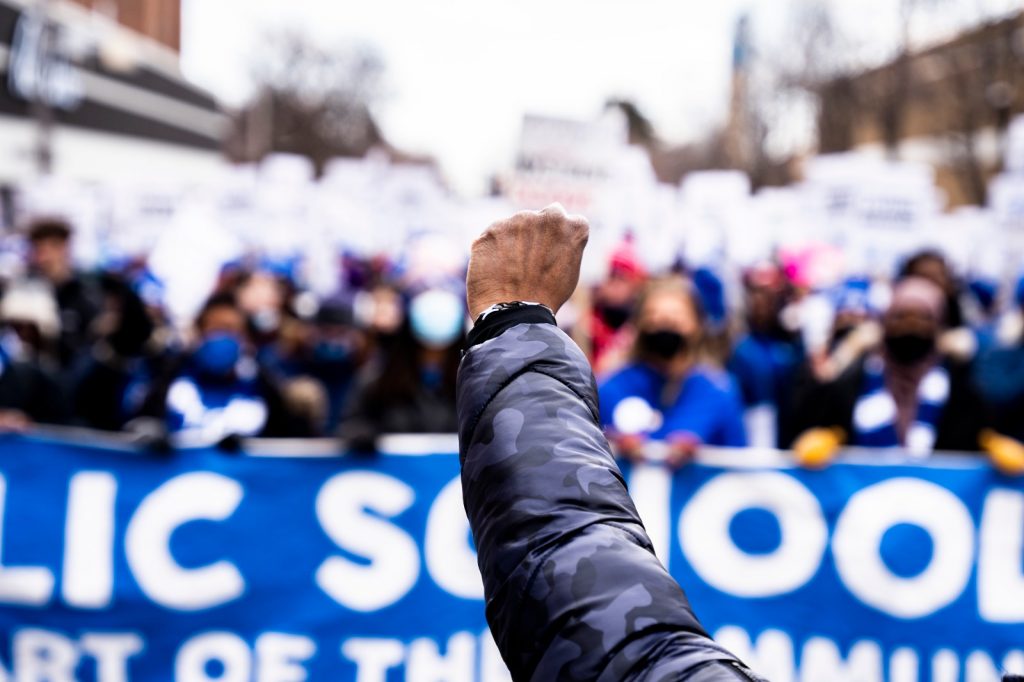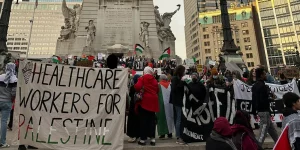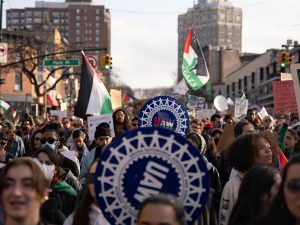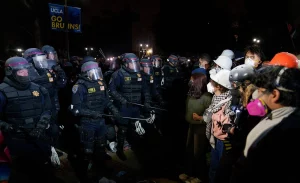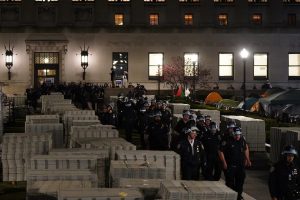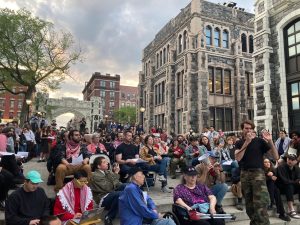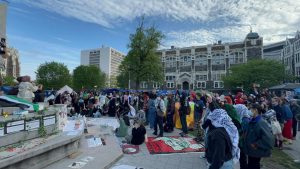On Sunday afternoon, Minneapolis educators were preparing to enter the second week of their strike. Larry Nelson, a high school art teacher, opened his studio for teachers and supporters from around Minneapolis to come and paint signs. There was a DJ set up outside with turntables playing 90’s hip hop. Kids were painting signs that read “support our teachers” and “teachers are our heroes,” while handfuls of teachers painted large banners made of cloth. The signs read “Smaller class sizes,” “Support and retention of BIPOC educators,” and more.
“You can’t really read most of the signs on the picket lines,” Nelson explained, referring to the picket signs with the union logos. “This is the grassroots way to get our message across. It’s not mediated by soundbites on TV news.” “And besides,” he said, “art is a way of bringing the community together and healing.”
When I walked in to the art studio, I was immediately greeted by a teacher painting a sign that read “Strike today, thrive tomorrow.”
“I’ve never felt as powerful as I feel in this strike,” she said.
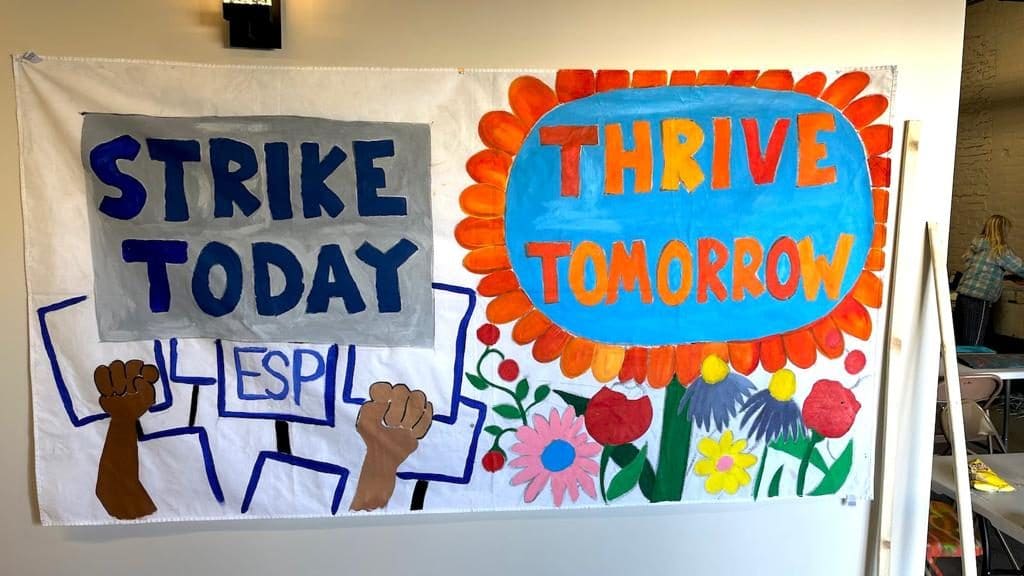
Minneapolis teachers haven’t been on strike in 50 years. Even seasoned teachers with decades of experience have never walked the picket line. But Minneapolis has a combative labor history; it’s the home of the Minneapolis General Strike of 1934, which was sparked by a Teamsters strike.
Minneapolis is in the midst of multiple labor struggles right now — public defenders voted to authorize a strike 5 days ago. Two Starbucks locations filed to unionize in the past month. And on Tuesday, SEIU food service workers announced an intention to strike and have begun their mandatory 10-day “cooling off” period.
I chatted with a teacher who was busy painting. “My daughter is a Starbucks worker at a store that is unionizing,” she told me. She called her daughter over who was painting a sign a few tables away. “I’m a senior and I haven’t had a normal year since my freshman year of college. My generation, we want to change things because we don’t even have a normal to go back to.”
I left the art studio with my comrade from Minneapolis and he took me to the third precinct, burned down during the BLM uprising, only a few blocks away. This whole place seems like a standard suburban area, surrounded by Target, Wendy’s, and some hipster looking bars. The precinct is still boarded up and there are no signs that it used to be a police station. Fewer still are any indications of the uprising of summer of 2020 following the murder of George Floyd.
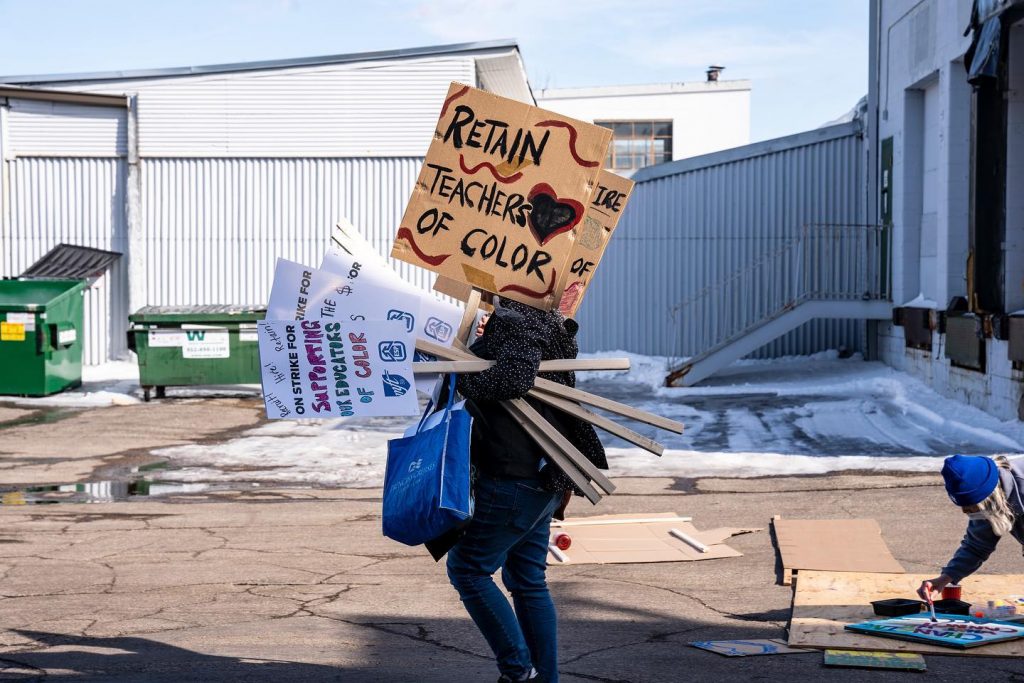
Across the street is the infamous Target on East Lake Street, one of the first sites of “looting.” Watching people justly rage following the police killing of Floyd forced the country to question who the real looters were — the person who took a TV from Target or the CEO of Target who every day makes an absurd profit from the sweat of workers who make poverty wages. Now that very Target, which was the initial “target” of BLM protesters, goes to great lengths to act as though it’s on the side of the BLM movement while it continues to hyper-exploit the majority Black and Brown low-wage workers at the store.
One of the educators told me “[Around here] there has been fucked up stuff since the begining. The pandemic and George Floyd from all of the smoke that was in the air and the glass shattering contributed to all of this. Energy doesn’t die and it was in the air. We’re using it for good.”
The Minneapolis educators’ strike is taking up several racial justice demands — hiring and retention of BIPOC educators being one of the central and most important of the demands. Some educators of color on the picket lines say they are afraid the message is getting lost and isn’t pushed by union leadership.
***********
The next day I woke up at 7 am and arrived at the South High School picket line. Teachers huddled around drinking coffee that had been donated from community supporters. It started to snow and my feet began to freeze. “This is nothing! Last week it was negative 14 degrees,” one of the teachers said. There were hand and toe warmers for teachers who spend all morning out in the frigid Minnesota winter temperatures.
“We shouldn’t have to walk the picket lines in cold weather like this. We shouldn’t have to walk around in the snow,” she added.
The educators gathered into a circle and everyone shared one word about how they were feeling: hopeful, enraged, solidarity, cold, supported, and more.
When the teachers dispersed to picket in different areas, I spoke with a teacher who was manning a table; “I have bad knees” she said, as the snow began to pick up. Yet, she fully supports the strike. “We haven’t had a raise that is equal to the cost of living in 20 years.”
Some of the teachers marched from South High School to the (in)famous Target. While for me the BLM uprising was a huge inspiration of a mass, combative, and spontaneous movement demanding justice for Black people and questioning the police, a central institution of capitalism, Minneapolis educators have shown me a different side. “The kids were traumatized by what happened to George Floyd”— a sentiment I hear versions of almost every time I ask. All the teachers I spoke to say that Black Lives Matter was good and important. Some participated in the streets, some made signs, and many talked to their students about it. But they all highlight that the kids need help processing it and that the support for students just isn’t there.
One teacher explained, “the student to counselor rate is 1 to 1,000.” Minneapolis wants to give bonuses to the police department for supposed PTSD. And yet, there aren’t nearly enough counselors to see a student population who lived through covid, an economic downturn, and witnessing brutal police violence.
At the picket line, teachers stood on both sides of a busy intersection waving signs that read “honk for teachers” and dancing on the sidewalk and in the middle of the road when the light turned red. There is so much energy.
Many teachers held signs about smaller class sizes. They said that they just can’t be good teachers with 35, even 40 kids in a classroom.
Teachers understand that they must fight for demands that go beyond their own” bread and butter” demands. They fight for the whole community and the most oppressed. One teacher wore a trans flag to bring attention to the harmful attacks on trans youth in Florida and Texas. Many held signs demanding BIPOC teachers in schools and many others demanded a living wage for Educational Support Professionals, who are overwhelmingly women of color.
Speaking from the podium of an afternoon rally, Syeda Omar, who has been an ESP for 14 years said, “ESP’s do a lot. We interterpret for parents, teachers and administrators… If there is a special education meeting, which takes at least 3 hours, you are translating constantly. You won’t stop [for] even 5 minutes. The schools will not function without ESP’s one single day.”
Omar said, “When you take your kids shopping, it’s a constant struggle. How many times have my kids asked me to buy something and I have to think…This is very emotional for me. Many times in the building they ask me, ‘what do you do during the summer’ and I say, ‘I stay home.’ My kids never went on vacation because ESPs make $24,000.”
Omar spoke at a rally held at the Davis Center where negotiations are ongoing. The school district has refused to concede to any of the teachers’ demands. The Superintendent of Public Schools, Ed Graff, hasn’t even attended most of the negotiations, a real slap in the face to teachers who are in the struggle. While he makes over $230,000 dollars and has received multiple wage increases, teachers and ESPs struggle to make ends meet.
To add insult to injury, there is a $9.3 billion surplus in Minnesota. This budget surplus is a significant increase from last year’s $1.6 billion surplus. In fact, the state has run budget surpluses for the last nine years. The money is there. The state just refuses to give it to schools or educators. It’s not fair and the teachers’ know it.
The energy of the teachers has been electric. Some teachers sang about the strike to the tune of “Bella Ciao.” A teachers’ marching band played “Solidarity Forever.” And dozens of teachers participated in a flash mob to the song “We’re Not Gonna Take It.”
On the picket line that day, speeches began with a land acknowledgement by Native teachers. From there we listened to speeches from Syeda Omar, a parent, a high school student, and a middle school student.
Marcia Howard, a Black English teacher who was deeply involved in the uprising for George Floyd, gave a riveting speech. She spoke to teachers’ fears of not being able to feed their kids or make rent. She called on teachers to support each other, to hold each other up, and to make sure that everyone in their school is taken care of. She demanded from the crowd “Hold the line. If you are scared, if you are worried, if you have doubts, hold the line, and hold each other.”
The teachers echoed the sentiment, chanting, “hold the line!”
Ilhan Omar also spoke to the crowd about her time in Minneapolis public schools. She didn’t address the fact that it’s her own political party keeping the teachers out on strike by refusing to address their demands.
The low wages and overcrowded classrooms are not an anomaly. Educators all over the country are leaving the profession. More than half of teachers across the country are considering quitting. Yet, each city is bargaining independently. We need a national educator’s movement for smaller class sizes, a living wage, BIPOC educators, and much more.
Over a thousand people who had gathered that day then dispersed, getting ready for the picket lines the next day. While a thousand teachers is powerful, I can’t help but think about all the other unionized workers who could and should be standing in solidarity. The unions around Minneapolis must stand up for teachers and build active solidarity.


